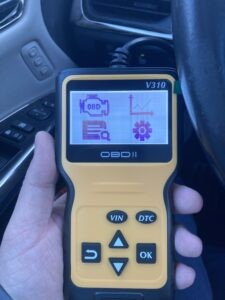Are you puzzled by that persistent “Check Engine” light? Or perhaps you’re just keen on understanding your car’s health without a costly trip to the mechanic? The V310 OBD II Car Diagnostic Tool might just be the answer you’re looking for. This user-friendly device empowers you to read and understand your vehicle’s diagnostic data, right in your own driveway. Inspired by real-world user feedback and designed for simplicity, the V310 is an accessible tool for both seasoned DIYers and those new to car maintenance. Let’s dive into how you can easily use the V310 OBD II scanner to get insights into your car’s performance and troubleshoot common issues.
Getting Started with the V310 OBD II Scanner: Design and Connection
The V310 car diagnostic tool is designed for straightforward use. It’s a compact, handheld device with an integrated cable and OBD II connector. This all-in-one design means there are no extra parts to manage, making it incredibly convenient. The first step is to locate your vehicle’s OBD II port. This port is your car’s diagnostic gateway, and thankfully, it’s usually easy to find. For most vehicles, you’ll find it under the dashboard on the driver’s side. If you’re unsure, a quick check of your car’s manual or a brief online search (like on YouTube) for “[your car make and model] OBD2 port location” will guide you. You might need to bend down to see it, but it’s generally quite accessible once you’re in the right position.
One of the smartest features of the V310 is its power source. It draws power directly from your car’s OBD II port. This means no batteries or charging are required! Simply plugging it in is enough to power it up. If the device illuminates and turns on when connected, you know you’ve established a proper connection with your vehicle’s system.
Step-by-Step Guide: Using the V310 Car Diagnostic Tool
Once you’ve connected the V310 scanner, you’re ready to start diagnosing. Here’s a simple walkthrough to get you started:
-
Initial Power-Up and Vehicle Identification: After plugging in, the V310 scanner will power on automatically. The first thing you can check is if it successfully reads your car’s Vehicle Identification Number (VIN). The V310 should display the VIN on its screen, confirming it’s communicating with your car’s computer.
-
Scanning for Diagnostic Trouble Codes (DTCs): The primary function of the V310 is to read Diagnostic Trouble Codes (DTCs). These codes are generated by your car’s onboard computer when it detects a problem. Navigate the scanner’s menu to the “Read Codes” or similar option. The V310 will then scan your vehicle’s systems for any stored codes.
-
Understanding and Clearing Codes: If the scan reveals any DTCs, the V310 will display them. It’s important to note down these codes. You can then research these codes online to understand what they mean. Websites and apps dedicated to OBD-II codes can provide detailed explanations. The V310 also offers the ability to clear codes. This can be useful for resetting the “Check Engine” light after addressing an issue or if you believe a code is a false alarm.
However, be cautious when clearing codes. Clearing a code doesn’t fix the underlying problem, and it might erase important diagnostic information that could be helpful for a mechanic if the issue persists. It’s generally recommended to understand the code and address the problem before clearing it, unless you are certain it’s a false or resolved issue. For instance, as the original user experienced, the V310 might primarily focus on engine-related codes and may not detect issues from other sensors, like a tire pressure sensor damaged during a repair.
- Navigating the V310 Interface: The V310 is designed to be user-friendly. Its interface typically involves simple menu navigation using buttons on the device. Explore the different menu options to familiarize yourself with its capabilities. Beyond reading and clearing codes, some models might offer additional features like viewing live data streams from your car’s sensors, which can be helpful for more in-depth diagnostics.
Final Thoughts: Taking Control of Your Car’s Diagnostics with V310
The V310 OBD II Car Diagnostic Tool is a valuable asset for anyone wanting to take a more proactive approach to car maintenance. Its ease of use, affordability, and portability make it an excellent alternative to more expensive, professional-grade scanners for basic diagnostics. Whether you’re a car enthusiast who enjoys DIY repairs or simply a car owner wanting to understand and address issues like a lit “Check Engine” light, the V310 empowers you to take the first step in diagnosing and resolving common car problems efficiently. By understanding how to use the V310 car diagnostic tool, you can save time and money, and gain a better understanding of your vehicle’s health.

